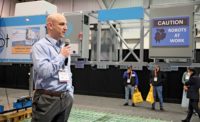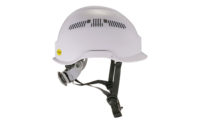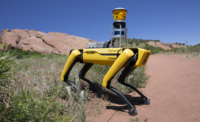Automation
Rebar-tying Robot Now Available for Direct Purchase as Robotics Firm Gains Industry Acceptance

TyBOT, the rebar-tying robot, has been used extensively on large installations such as bridge decks.
Photo courtesy Advanced Construction Robotics
In a move it says reflects not only growing demand but the industry’s broader embrace of jobsite robots, Advanced Construction Robotics has announced that it is now offering its rebar-tying robot through direct sales in addition to ongoing service arrangements.
TyBOT's gantry-mounted robotic arm is able to tie rebar intersections on large rebar installations such as those used in bridge decks. With its largely hands-off operation, TyBOT automates much of what is typically seen as an onerous and physically taxing jobsite task.
The robot was first used on a real construction jobsite in 2017, and has been deployed on dozens of projects since. The new TyBOT 3.0 standard model has a working width of 67 in. at a cost of $425,000. With multiple attachments available, the working width can be extended to 117 in. in a fully configured version that goes for $455,000. Training on operating the rebar-tying robot is included in the sale price, as well as future software updates and access to an online portal to track its usage and productivity. Other options include other modes of travel for non-bridge projects and a new carry function for transporting materials around the jobsite.
Until now, working with TyBOT came through a robotics-as-a-service model with its manufacturer, Pittsburgh-based Advanced Construction Robotics. “It was always a question [from customers] of ‘can I buy one?’ as we walked them through this RaaS model,” says Danielle Proctor, president and CEO of ACR.
The company will still offer rentals of the TyBOT in the future, and is exploring other distribution options. But Proctor says the real obstacle to direct sales of the robot had been the necessary training to operate it. “A big thing for us was coming up with a training curriculum that was repeatable and explainable,” she says. “With TyBOT, our goal was always to make this thing seamlessly integrated into the tools of the trade.”
Users have overcome initial reservations to fully endorse the robot. Extensive early engagement with union ironworkers and specialty contractors helped win over some skeptics, and direct input from users contributed to the current 3.0 version of TyBOT, notes Proctor.
“We were not only asking customers for feedback, but we had partners who were involved from day one,” adds Stephen Muck, ACR founder and executive chairman. “We were integrated with users throughout the process, from conception of the idea through proof-of-concept and beyond ... when we introduce a product to market, we want it to be economically viable and solve real problems.”
Muck says that most users bring on a TyBOT not to reduce their labor costs or even address a labor shortage, but as a multiplier for their crews to tackle more and larger jobs. “Some want lower labor costs, yes—but more want to do more work and make more money doing more volume.”
And having a robot of your own that doesn’t require ongoing coordination with ACR is already changing how clients use their TyBOTs, says Proctor. “We’ve been talking preemptively to a few users about how they would like to get their units out there, and one said, 'Oh my gosh, it’s for sale now. We have so many other jobsites we want to get it out to.’ It becomes this flexible tool you can apply wherever it is needed.”
ACR is starting to take orders for the first few direct sales of TyBOT 3.0 units, with an expected delivery in the first quarter of 2025.





